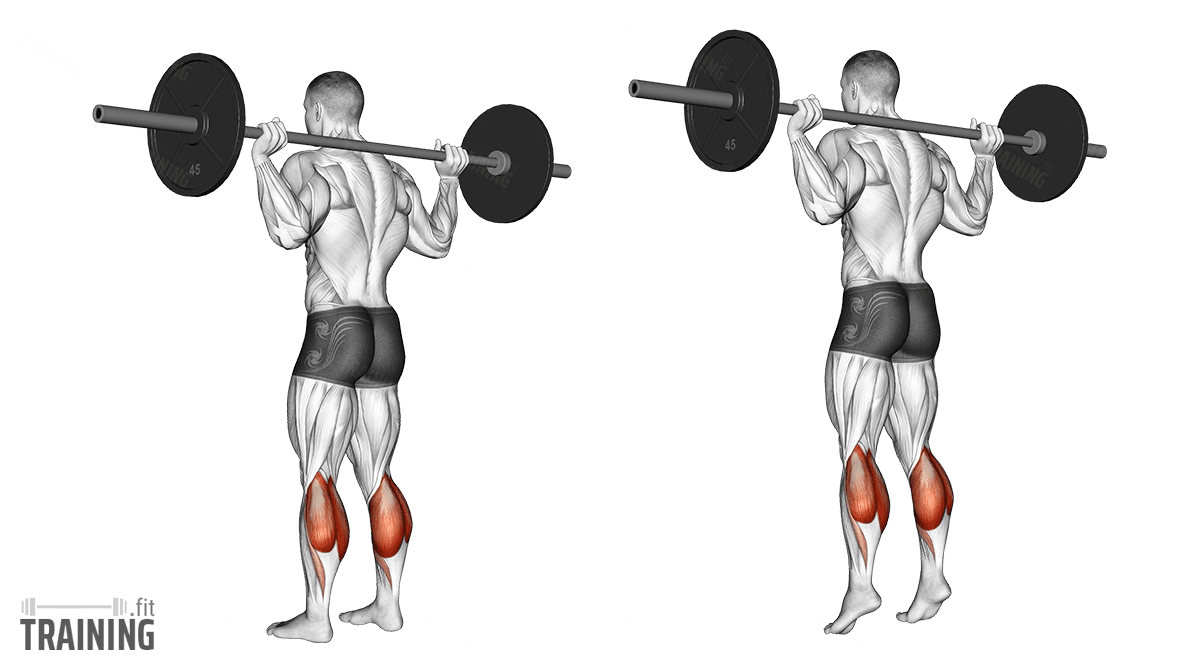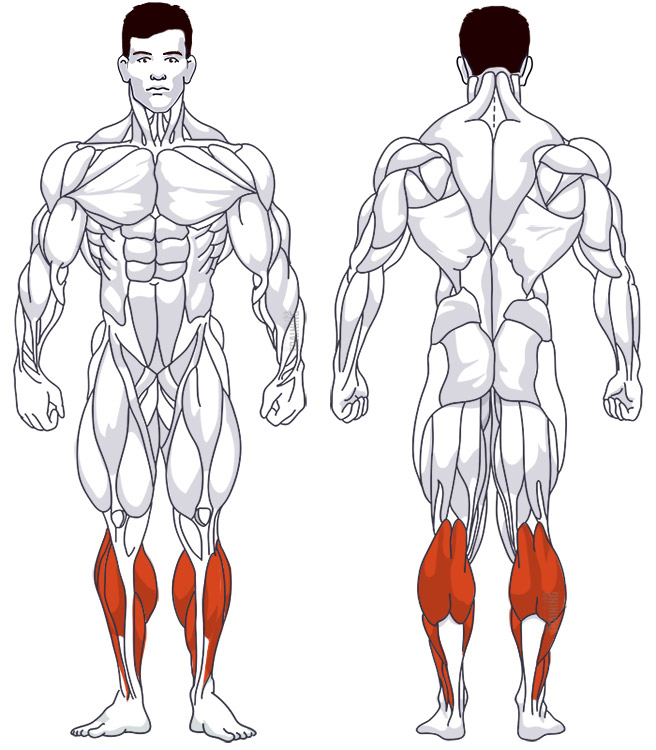Standing Barbell Calf Raise
Isolation exercise, Free weightsOverview

Main muscles
- Lower leg: Short fibula muscle
(Musculus peroneus brevis) - Lower leg: Long big toe flexor
(Musculus flexor hallucis longus) - Lower leg: Long fibular muscle
(Musculus fibularis longus) - Lower leg: Long toe extensor
(Musculus extensor digitorum longus) - Lower leg: Soleus muscle
(Musculus soleus) - Lower leg: Anterior tibial muscle
(Musculus tibialis anterior) - Lower leg: Twin calf muscle
(Musculus gastrocnemius)
Training plans
Standing Barbell Calf Raise is a suitable substitute for similar exercises in or as a supplement to various training plans.
Standing Barbell Calf Raise: Basics and alternatives

Involved main muscle groups:
Standing Barbell Calf Raise
The standing barbell calf raise follows the same movement as the standing calf raise machine exercise: the weight on your back, neck, and shoulders is moved up and down by raising and lowering your heels.
However, standing calf raises with a barbell are a bit more challenging than the machine exercise. With free weights, you need to maintain conscious body tension and better balance in the stretched position.
As alternatives, you can also perform the seated calf raise machine exercise, the seated barbell calf raise variation, or seated calf raises with dumbbells.
Correct execution
To perform standing barbell calf raises, you can either hold the barbell behind your neck (like in squats) or in front of your hips (like in deadlifts). However, holding the barbell in front of your body shifts the weight onto the balls of your feet. If you hold the barbell behind your neck, the weight lies along the body’s centerline directly in the middle of your feet or on your heels. This creates a better training stimulus for the target muscles and more natural stabilization. Therefore, this variation will be described below.
To avoid discomfort from the barbell on your neck, either wrap your towel around the bar’s center or use a barbell pad.
Video tutorial
Step-by-step instructions
Adjust the rack height before stepping into the power rack to lift the barbell. The bar should be about at the height of your armpits, making it easy to lift the weight out of the rack.
Step into the rack so that the barbell rests on your neck and touches it. To do so, bend your knees slightly. Your foot position should be shoulder-width apart.
Place your hands on the barbell from behind, wider than shoulder-width apart.
Lift your body so that the bar presses against the lower part of your neck. The bar should not press your head forward.
In this position, your buttocks are slightly stretched backward, your lower back forms a very slight arch, and your upper back is straight.
Lift the barbell out of the rack by straightening your body. Take a few steps away from the rack with the barbell on your neck.
Stand with your feet shoulder-width apart. The weight is now resting on your neck. Your lower back still forms a slight arch, and your upper back is straight. Do not hunch.
Choose your body position so that the barbell’s weight is evenly distributed over your feet. You are now in the starting position.
Raise your body by extending your ankle and lifting your heels off the ground. Raise your heels as far as possible without discomfort and without risking losing your balance. At the end of the movement, hold for a brief moment, and then lower your body slowly and in a controlled manner back to the starting position.
Common mistakes and injuries
For standing barbell calf raises, maintaining proper back posture is almost as important as for squats: keep your back slightly arched throughout the exercise. Do not round your back, as this puts tremendous strain on your intervertebral discs.
Also, do not bend your knees and straighten them again, as this shifts the muscle focus to your thighs. Your knees should be slightly bent throughout the entire exercise to avoid unnecessary stress on your joints.